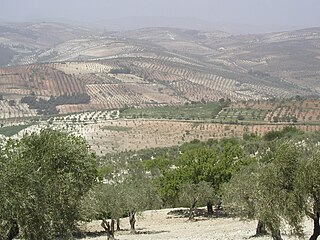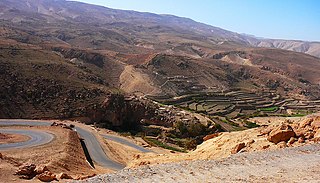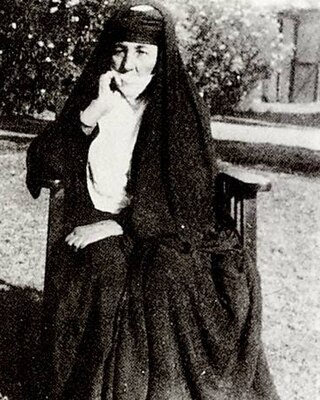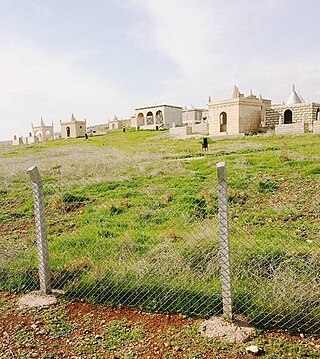
Duhok is a city in the Kurdistan Region of Iraq. It is the capital city of Duhok Governorate.

Lalish is a mountain valley and temple located in the Nineveh Plains of northern Iraq,. It is the holiest temple of the Yazidis. It is the location of the tomb of the Sheikh Adi ibn Musafir, a central figure of the Yazidi faith.

Kurd Mountain or Kurd Dagh is a highland region in northwestern Syria and southeastern Turkey. It is located in the Aleppo Governorate of Syria and Kilis Province of Turkey. The Kurd Mountain should not be confused with the neighboring Jabal al Akrad, which is located further southwest in Latakia Governorate.

Bohtan was a medieval Kurdish principality in the Ottoman Empire centered on the town of Jazirah ibn 'Omar in southeastern Anatolia. The official religion of this principality was Yezidism in 14th century, although the rulers eventually converted to Islam, Bohtan constituted the third major Yezidi enclave after Shekhan and Sinjar until the 19th century.

The following is a list of tribes of Kurdish people, an ethnic group from the geo-cultural region of Kurdistan in Western Asia.

Yazidis, also spelled Yezidis, are a Kurdish-speaking endogamous religious group indigenous to Kurdistan, a geographical region in Western Asia that includes parts of Iraq, Syria, Turkey, and Iran. The majority of Yazidis remaining in the Middle East today live in Iraq, primarily in the governorates of Nineveh and Duhok.

The Sinjar Mountains, are a 100-kilometre-long (62 mi) mountain range that runs east to west, rising above the surrounding alluvial steppe plains in northwestern Iraq to an elevation of 1,463 meters (4,800 ft). The highest segment of these mountains, about 75 km (47 mi) long, lies in the Nineveh Governorate. The western and lower segment of these mountains lies in Syria and is about 25 km (16 mi) long. The city of Sinjar is just south of the range. These mountains are regarded as sacred by the Yazidis.
The Muzuri; مزووری are a Kurdish tribal group inhabiting the northernmost areas of Iraqi Kurdistan. They live to the west of Margavar and. Muzuri is one of the oldest Kurdish tribes in Kurdistan.

The Sinjar District or the Shingal District is a district of the Nineveh Governorate. The district seat is the town of Sinjar. The district has two subdistricts, al-Shemal and al-Qayrawan. The district is one of two major population centers for Yazidis, the other being Shekhan District.
Nelida Fuccaro is a historian and professor of modern Middle Eastern history at the New York University Abu Dhabi.

Mira Meyan Khatun or Mayan Khatun — Yazidi princess, a regent of Yezidi Emirate of Sheikhan in 1913-1957.
The 1935 Yazidi revolt took place in Iraq in October 1935. The Iraqi government, under Yasin al-Hashimi, crushed a revolt by the Yazidi people of Jabal Shingal against the imposition of conscription. The Iraqi army, led by Bakr Sidqi, reportedly killed over 200 Yazidi and imposed martial law throughout the region. Parallel revolts opposing conscription also broke out that year in the northern and mid-Euphrates regions of Iraq.

Yazidism in Turkey refers to adherents of Yazidism from Turkey, who remained in Turkey after the dissolution of the Ottoman Empire. The Yazidis living in Turkey during and after the second half of the 20th century gradually left for European countries. In the 1980s, there were 60,000 Yazidis situated in Beşiri, Kurtalan, Bismil, Midyat, Idil, Cizre, Nusaybin, Viranşehir, Suruç and Bozova. Today, these places are almost empty due to exodus to Europe which was provoked by political, religious and economic difficulties. Today only small number remain in villages around Midyat, Viranşehir, Çınar and Beşiri. According to the census of 2000, only 423 individuals adhering to Yazidism remained in the country.

The Ezidkhan Command for Liberating Sinjar, known as the Sinjar Alliance, is a joint command of two–initially three–Yazidi militias, the Sinjar Resistance Units (YBŞ), and the Êzîdxan Women's Units (YJÊ). Both of the remaining two militias are supported by the Kurdistan Workers' Party (PKK).

The persecution of Yazidis has been ongoing since at least the 12th century. Yazidis are an endogamous and mostly Kurmanji-speaking minority, indigenous to Kurdistan. The Yazidi religion is regarded as "devil-worship" by Muslims and Islamists. Yazidis have been persecuted by the surrounding Muslims since the medieval ages, most notably by Safavids, Ottomans, neighbouring Muslim Arab and Kurdish tribes and principalities. After the 2014 Sinjar massacre of thousands of Yazidis by ISIL, which started the ethnic, cultural, and religious genocide of the Yazidis in Iraq, Yazidis still face discrimination from the Iraqi government and the Kurdistan Regional Government.

Yazidism in Iraq refers to adherents of Yazidism from Iraq who reside mainly in the districts of Shekhan, Simele, Zakho and Tel Kaif, in Bashiqa and Bahzani, and the areas around Sinjar mountains in Sinjar district. According to estimates, the number of Yazidis in Iraq is up to 700,000. According to the Yazda aid organization, just over half a million Yazidis lived throughout Iraq before August 2014.
Alphabetical index of articles about the Yazidis, and their history and culture.

Dasini or Daseni, Dasiniyya, Tasini, Dasiki is a Kurdish yazidi tribe and Ethnonym of Yazidis. The tribe resided near Mosul, Duhok, Sheikhan, Sinjar and all the way to the west bank of Greater Zab river.

![Post-Card by Sarrafian brothers of Beirut of a group of Yezidis of Jabal [mountain] of Shingal at the Iraqi-Syrian border. The Yezidis started settling in the mountain beginning in the 13th. century following the severe persecution by the Zengid Atabeg of Mosul, Badr al-Din Lulu. and later by the frequent Ottoman campaigns against the Sheikhan Yezidis north of Mosul. The mountain was a strong hold of the Nestorian Christians, whose Diocese ceased to exist after the 17th. century. The first of many campaigns by the Ottoman Turks, against the Yezidis of the Mountain, called by the Turks "THE SACLI DAGH", the mountain of the "HAIRY ONE'S", was carried by Melek Ahmad Pasha, the Vali of Diyarbekir [ 1640], the second by the Ottoman Firari Mustapha, the last occupation was in 1918, and directed against Hemoye Shero, the Sheikh of the Fuqara Yezidis, who refused to hand in the Christians refugees who sought shelter in the mountain from S.E.Turkey. Yezidi of Jabal Shingal. Yezidis of Jabal.jpg](http://upload.wikimedia.org/wikipedia/commons/thumb/c/c4/Yezidis_of_Mount_Sinjar.jpg/220px-Yezidis_of_Mount_Sinjar.jpg)













